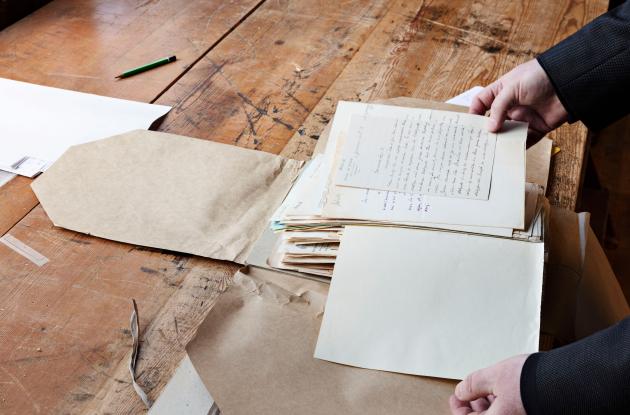History of the manuscript collection
The manuscript collection was created at the same time as Royal Danish Library and is divided into a large number of sub-collections, each with their own history. Get a quick overview here.

Photo: Laura Stamer
Manuscripts in Frederik III's Royal Library
The manuscript collection was established at the same time as King Frederik III founded Royal Danish Library, shortly after he became king in 1648. In 1655, Frederik III bought Tycho Brahe's handwritten observation protocols, and in 1656 he received three Icelandic manuscripts as a gift from the bishop of Skalholt in Iceland, Brynjólfur Sveinsson.
In the years 1661-1665, the library additionally received manuscripts from the large private libraries of Joachim Gersdorff, Laurids Ulfeldt and Peder Scavenius.
The great accessions of the 18th century and the logical division of the manuscript collection
Manuscripts from the Gottorper Library - including a fragment of 9th-century Lukrets - became part of the collection in the period 1713-49 and Otto Thott's manuscript collection in 1785. When the library received Otto Thott's manuscript collection (of 4054 catalogue numbers), the existing collection of manuscripts closed and was named the Old Royal Collection (abbreviated GKS in Danish). Then a new collection was created, called the New Royal Collection (abbreviated NKS in Danish), which was in use until the 1990s.
Treasures in the collections GKS, Thott and NKS
Some of the library's biggest treasures are found in the three collections GKS, Thott and NKS. The Old Royal Collection includes, for example, Robert de Clary's crusader account (GKS 487 folio), the Kristina Psalter (GKS 1606 quarter) and the Hamburg Bible (GKS 4 folio).
The Thott collection includes the Copenhagen Psalter (Thott 143 folio), a manuscript with Dante's divine comedy (Thott 411 folio) and “Hjertebogen”, the oldest Danish manuscript with folk songs (Thott 1510 quarter).
In the New Royal Collection you will find, for example, the Angers fragment with parts of Saxo's Danish history (NKS 869g quarter), a 14th century manuscript with Henrik Harpestreng's medical book (NKS 66 octave) and surviving papers by figures such as Jens Baggesen, Frederikke Brun, JP Jacobsen and Karin Michaëlis.
Archives by the great writers of the 19th century enter the 20th century
In 1905, the Collin collection was included with large collections of manuscripts and letters from Hans Christian Andersen. In 1938, we received manuscripts from the Copenhagen University Library, which at that time had not yet been merged with Royal Danish Library. Among the manuscripts from the university library was Søren Kierkegaard's archive. In 1941, the library also received the Grundtvig archive from the National Archives.
The manuscript collection's sub-collections
The manuscript collection is thus divided into a number of sub-collections and independent personal archives, each with their own history. In addition, there is the continuous growth of physical and digital documents.
The name of the sub-collection is marked in the library system and also appears in the manuscript or archive's placement.
You can read a description of the individual, historical collections in Carl S. Petersen's description of the manuscript collection from 1943, which is digitally available in the library system. The text is in Danish:
Carl S. Petersen: Det kongelige Biblioteks Haandskriftsamling. Kbh: Munksgaard, 1943.
You can read about developments in the 20th century in the introduction to:
Birgitte Possing and Bruno Svindborg (eds.). "Det Kongelige Biblioteks Håndskriftafdeling: erhvervelser 1924-1987: vejledning i benyttelse". Museum Tusculanum, 1995, pp. 11-26.
The State and University Library's manuscript collection
The State and University Library was established in 1902, and the manuscript collection was founded at the same time with the manuscripts that came to the library through CF Wegener's library, Regensburg's collection and Jens Vahl's library. The collections contained manuscripts, entire handwritten books, and mixed correspondence as well as a large group of archival material about Schleswig-Holstein.
The collection of manuscripts has grown steadily over the years and has also received material related to Aarhus City. For example, Aarhus Mølles Arkiv, Selskabet Polyhymnias Arkiv and lending protocols from Aarhus Stifts offentlige Bibliothek.
The manuscript collection also contains papers from some of the State and University Library's own leaders, including Vilhelm Grundtvig, Emanuel Sejr and Karl V. Thomsen.
At the merger in 2017 between Royal Danish Library and the State and University Library, the collection became part of Royal Danish Library's collections.